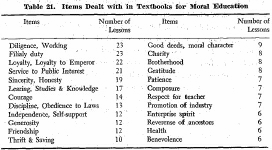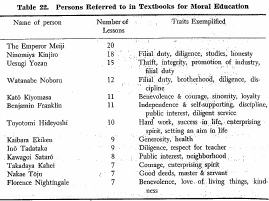| Home > Policy > White Paper, Notice, Announcement > White Paper > JAPAN'S GROWTH AND EDUCATION 1963 > CHAPTER |
||
Morals
In the early years of the Meiji Era, the contents of education were derived largely from European countries and the U.S.A.. Traditional Japanese concepts were neglected. Soon, however, criticism developed rquining reconsideration of this trend and pointing out the danger of attaching too much importance to intellectualism and of underestimating the disciplinary value of ethics. The old ethics of Confucianism came into renewed importance. The Leading Principles of Education, as proclaimed by the Emperor Meiji in 1879, stressed tlae moral values of humanity, justice, loyalty and filial duty, and stated that moral education and practical learning constituted the fundamentals of education. Consequently, moral education increased in popularity, and the borrowed occidental concepts or morals became infused with the ethics of Confucianism. In 1880, the use of Japanese translations of foreign textbooks was prohibited and the "Principles of Children's Education", issued in 1882, provided national standards of moral education. Thus, national unification of ideas was effected by universal education in the basic ethical principles of Confucianism, deeply rooted in the minds of the Japanese people from the Tokugawa Era (1600-1867). Moral education centered around readings from the Analects of Confucianism, the Book of Filial Duty and other similar documents.
The Imperial Rescript on Education was proclaimed in 1890 and it was decided that moral education should be conducted in line with the gist of the Rescript. The textbook on morals, issued as one of the government-authorized textbooks, provided lessons on loyalty, filial duty and the precedence of age, fraternity, love and benevolence, etc., and the greater part of the contents was devoted to tlae lesson on national loyality under the influence of the Sino-Japanese War. After the war, that is around 1900, many revered figures in Japanese history were refered to in the textbook and the lessons on diligence, modesty, thrift, care of health, etc., were added. These lessons provided the ethics of importance in the period of developing modern industrialism and served to instill the ideas of diligence, thrift and good health into the minds of the nation.
Beginning in 1904, textbooks in moral education compiled by
the nationa1 government were prescribed for use in all schools. The contents
of these textbooks dealt variously with the morals and ethics of individual conduct,
and relationships with the local, national and international communities. Creates
stress was placed on individual conduct in the 1907textbook, least in textbooks
used during the period of World War ![]() ,
beginning in 1941. In the latter years, obligations to the State were most emphasized,
while least emphasized in the earlier years. During tlae period around 1920 to
30, lessons concerning community relations reflected the world trend toward democrac5'.
,
beginning in 1941. In the latter years, obligations to the State were most emphasized,
while least emphasized in the earlier years. During tlae period around 1920 to
30, lessons concerning community relations reflected the world trend toward democrac5'.
It is notworthy that the contents of moral education have closely paralleled the needs of socio-economic development of the country, with the greater number of lessons being devoted to such traits as diligence, thrift pursuit of knowledge, consideration for the public good, discipline, independence, self-support, courage, etc. The fact that the rapid economic progress of this country has largely been dependent upon the high rate of savings (l5-20 per cent of the national income) since around 1900, would indicate that moral education has been effective in urging the abo1ition of waste and in teaching the moral value of thrift and saving.
The lessons in morals were taught mainly by citation of examples of the deeds or words of historical characters. The frequency of citation of the various historical characters and the traits they exemplified are shown in Table 22.


The lessons in morals were taught mainly by citation of examples of the deeds or words of historical characters. The frequency of citation of the various historical characters and the traits they exemplified are shown in Table 22.
In addition to the figures indicated in the above table, Kusunoki Masashige, worrior in the feudal age, in the lesson on loyalty; Kiguchi Kohei, a bugler in the Japanese army, and Captain Sakuma of the Japanese navy submarine force, in the lesson on courage; and Columbus, in the lesson on endurance, were often cited as examples.
The Emperor Meiji was the leader who laid the foundation of the development of this country. Ninomiya Kinjiro made himself a distinguished figure through diligence and thrift, and also by applying himself to his studies with untiring zeal. Uesugi Yozan contributed greatly to the development of industry by advancing the principles consolidating economy and morals. Toyotomi Hideyoshi was a typical person who made a great success in life. The words and deeds of these historical personages were honored as examples to be followed by individuals and served to encourage the nation in the habit of diligence. In addition, it should be pointed out that those models of character were selected not from among those who belonged to certain limited segments of the population, but from all ranks and classes, even to the inclusion of foreigners. By providing living examples of successful individuals of all economic and social classes, who achieved success through their own ability and efforts, pupils were given hope and courage.
Kusunoki Masashige ( -1336. Loyal and resourceful general; fought for and offered his life for the Emperor)
Kiguchi Kohei (1872-l894. Brave bugler; never stopped blowing a bugle for dash, when he was shot by the enemy.)
Captain Sakuma (l879-l910. Naval officer; and whth coolness until death, when his submarine sank in accident.)
Emperor Mdji (1852-1912. Emperor of Japan; introduced the foreign civilization to Japan and established a foundation of socio-economic modernization of the country.)
Ninomiya Kinjiro (1787-1856. Leader of reclamation of waste land, promotion of industry and reestablishment of local economy; born as a son of poor peasant and studied by himself while working hard.)
Uesugi Yozan (1751-l822. Feudal load; planned economic development, stimulated thrift and promotion or industry.)
Toyotomi Hideyoshi (1536-1598. Born as a son of the lowest class footman; been promoted in status step by step to the premier with his great ability in planning and leading; brought the country under his authority.)
Japanese Language
During the approximate period of l868-l889, the curriculum of Japanese language was designated as "Reading", the contents of which ranged from Japanese language to ethics, history, geography, science, etc. This practice continued to exist through subsequent periods, and in the national textbooks for Japanese language, the historical figures referred to in the textbooks for ethics, such as Toyotomi Hideyoshi and Kusunoki Masashige were also found in the textbooks for Japanese language.
Since 1900, the subject formerly called "Composition" became "Free Composition" hereby emphasizing the change from formal composition based on model textbook sentences to free expression by pupils, in their own way, of their daily life experiences. This is believed to be the first step taken toward integration of oral and written Japanese language instruction. At the same time, the standard number of Chinese characters (kanji) to be taught in the elementary school was limited to about 1,2OO. This continued in effect until 1908.
The number of pages of text and illustrations in the national textbook for Japanese language increased considerably between 1904 and 1940, with some slight reduction thereafter, as shown in the following tabulation.
History and Geography
The history textbooks published during the approximate period of l868-1889, were general world-history textbooks, with little stress on Japanese history. Japanese history gradually supplanted world history until the latter was discontinued entirely, and history textbooks came to deal almost entirely with the achievements of the Emperor's reign and the development of the State and its constitution.
In the geography textbook published around 1877, only the local geography was described, not the geography of the country as a whole. In the later national textbook, however, national geography was included, and in the textbooks of 1910-1925 the geography of foreign countries was added.
In the period following World War I, from 1920 to 1935, the
prevailing spirit of international cooperation was reflected by expansion of
the treatment of foreign countries in the geography textbooks. This trend was
reversed in the textbooks published during and preceding World War ![]() .
.
Major increases in the number of pages in the history and geography textbooks between 1904 and 1940, as shown in the following tabulation, are indicative of the increasing importance attached to these subjects.
Science and Mathematics
For the teaching of science, Japanese translations of foreign textbooks were used in the period around 1870-1885. Considerable portions of their contents had no relationship to the circumstances or environment of Japan.
Since about 1887 textbooks in elementary science came to contain systematic explanation of natural phenomena, their co-relations and the relations between natural phenomena and man. The teaching methods of science changed as years went by from that of simple textbook presentation to learning through experiments and observation. After World War I, the importance of science teaching was more definitely recognized, instruction was expanded and greater stress was placed on experimentation. The number of pages in the basic science textbook, for example, increased from 50 in 1910 to 84 in 1918.
The contents of mathematics instruction during the period of l868-1890 were constructed with less consideration to the pupils' scholastic level than to the teachers' convenience. The teaching of the theories of arithmetic was regarded as of major importance, and constituted a heavy work load for pupils. From around 1900, the teaching of commercial arithmetic was begun. The metric system was adopted in 1910. Later, emphasis was given to the application of arithmetic to daily life (applied arit1arnetic).
| Back to Top | MEXT HOME |